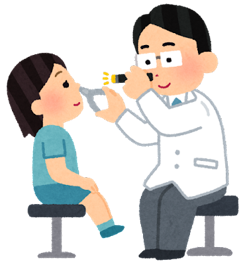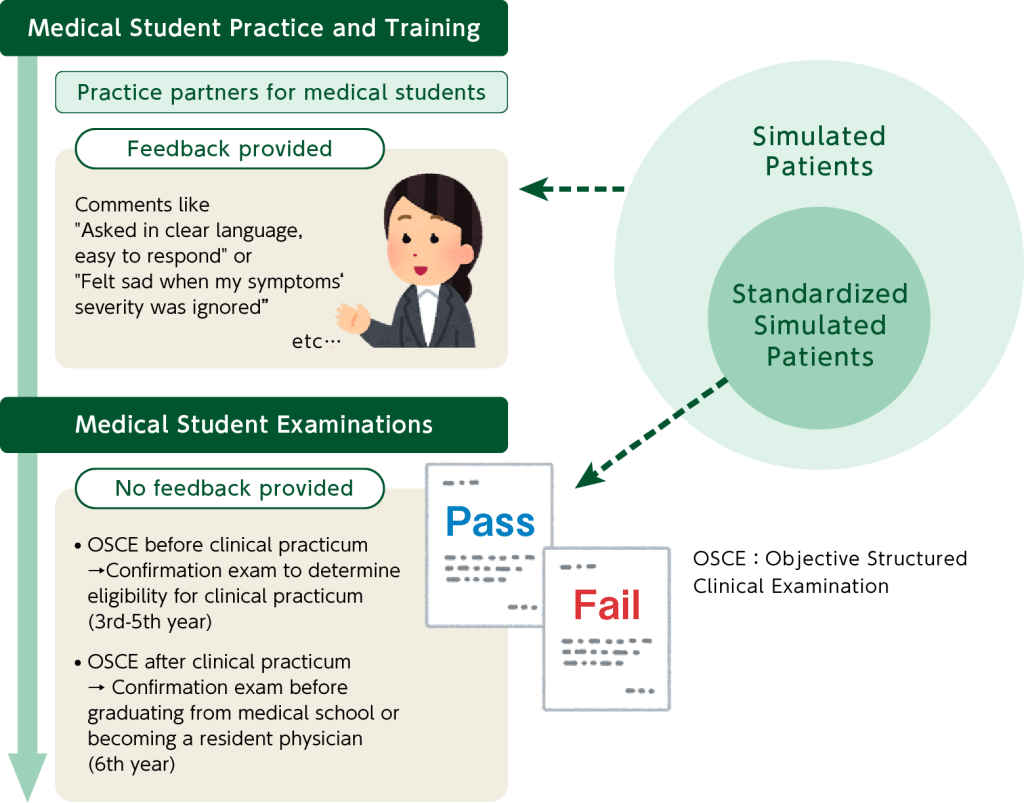What‘s simulated patients ?
A Simulated Patient (SP) refers to an individual who plays the role of a patient when students in the medical field practice medical interviews and examinations. Following specified scenarios, the simulated patient behaves like a real patient, assisting medical students in practicing how to appropriately interact with patients.

What do simulated patients do?”
(History Taking)
- Reasons for the visit and symptoms
- Practice partner for skillful and considerate inquiry

- Head, chest, abdomen, extremities, neurological examination
- Visual inspection, auscultation, percussion, palpation
- Various other examination methods

1. Medical Interview (History Taking)
The process where a doctor asks a patient about the reason for their visit and symptoms is referred to as a medical interview. Since patients are not medical professionals, medical students need to practice extracting medically relevant information skillfully. Additionally, considerations such as how to inquire, which may include elements causing anxiety for the patient, are important in medical interviews. Such interactions require the presence of simulated patients, acting as the counterpart.
2. Physical Examination
For instance, simply reading textbooks is insufficient to understand how to conduct an abdominal examination. To learn how to guide patients into suitable positions for examinations, or how to communicate effectively before pressing on the abdomen to alleviate patient anxiety, students must acquire these skills before becoming physicians.
* Not all simulated patients participate in both medical interviews and physical examinations.
Role of Simulated Patients

1. Practice and Training for Medical Students
SPs can provide feedback to medical students from the perspective of the role they portray. This unique form of collaborative learning plays a significant role in enhancing medical students’ interpersonal and empathetic skills. It is crucial for SPs to offer feedback on how the actions and behaviors of medical students affected the SP’s own emotions, generated trust, and more (Reference 11).
This role cannot be fulfilled by emotionless AI or robots. Moreover, instead of merely portraying a typical patient, it is crucial for SPs to communicate how they personally felt to the medical students. In that regard, healthcare professionals like doctors or medical students are not well-suited as SPs, while individuals from the general public are more suitable for this role.
2. Examinations for Medical Students
Another critical role of SPs involves cooperation in examination processes. In exams where pass or fail decisions carry substantial consequences, SPs are trained in a standardized manner to ensure fair and equal opportunities for individual medical students. SPs that play a crucial role in such exams are referred to as “standardized simulated patients” (Reference 22).
In Japan, all medical students undergo a standardized practical exam known as the Objective Structured Clinical Examination (OSCE), which has been officially implemented. This exam has become a mandatory requirement for advancing in medical education. To conduct fair and impartial exams that influence the lives of medical students, SPs involved in practical exams need to adhere to certain protocols, requiring them to demonstrate consistent performance based on memorized detailed scenarios, rather than offering flexible and rich emotional feedback (Reference33).
References:
- Berenson LD, Goodill SW, Wenger S. Standardized patient feedback: making it work across disciplines. J Allied Health. 2012;41(1):e27–31 ↩︎
- Lewis et al. The Association of Standardized Patient Educators (ASPE) Standards of Best Practice (SOBP). Advances in Simulation. 2017; 2:10 ↩︎
- Japan Accreditation Council for Medical Education (JACME) – Common Test Implementation and Evaluation Organization Website ↩︎
About Kyoto University Simulated Patients Association
The Kyoto University Center for Medical Education and Internationalization regularly conducts training sessions to cultivate simulated patients. These individuals play the role of patients in medical interviews conducted as part of the “Introduction to Clinical Practicum Course” for fourth-year students at Kyoto University Medical School. Additionally, they contribute to medical education research, particularly in areas such as physical examination techniques and diagnostic studies.
Furthermore, they assist in playing the role of patients during the medical interview examination for the Common Test (OSCE) conducted before the commencement of clinical practicum. Kyoto University has designated simulated patient training coordinators who provide support for individuals seeking certification as standardized simulated patients.
Recruitment of Simulated Patients
The Kyoto University Center for Medical Education and Internationalization is actively seeking individuals willing to contribute as simulated patients for student education.
・Applicants up to 70 years old (as training will be required for a few years)
・Applicants who can exchange files via PC email
If you are interested, please contact us at the following:
TEL:075-753-9454
FAX:075-753-9339



